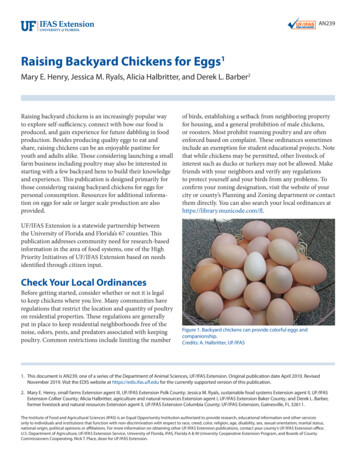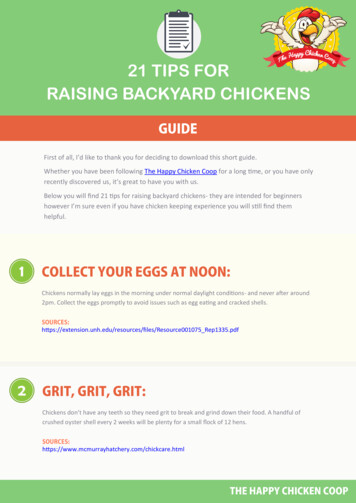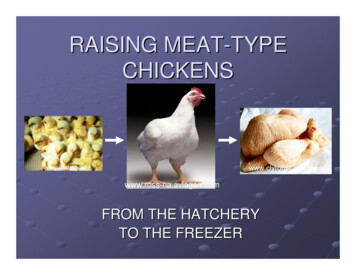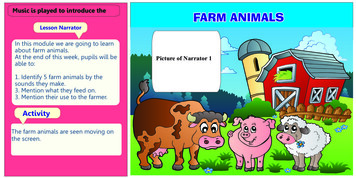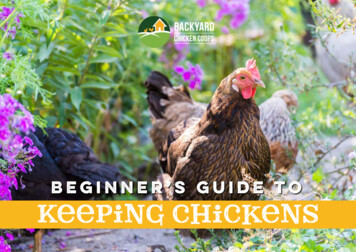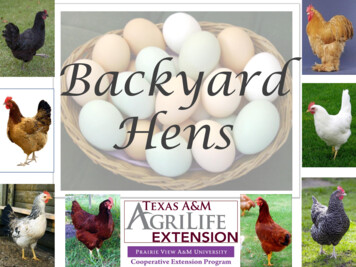
Transcription
BackyardHens
PURPOSE OF THISPRESENTATION IS: To present the concept of “Backyard Basics” To create an awareness of the possibility ofraising backyard chickens for:– Fresh eggs to eat & share– Natural insect control– Educational projects for kids– Extra income for kids & you– Adding a little “country” toyour urban backyard
Raising small flock of backyardhens has become increasingpopular over the past couple ofyears. Membership in BackyardChickens went from 50 in 2007 toover 61,000 today. Cover article in OrganicGardening Magazine June/July2010 July 12, 2010 Time Magazinearticle covered the growingpopularity of BYCs.
THE TOP TEN REASONS FORRAISING YOUR OWN CHICKENS1. Taste & Freshness - Personalchickens are the ultimatesource of truly fresh eggs,and nothing beats the flavorof home raised chickens2. Educational - Your kids willacquire plenty of knowledgeof life-cycles, feeding habits,animal characteristics, etc .Junior?
THE TOP TEN REASONS3. Health & Safety - There'svirtually no risk of antibioticresistant bacteria living inhome raised meat or eggs4. Great Pets - Safer than dogs!Chickens make great petsthat require little care,produce fertilizer, eat bugs,and are very cute
Not Much Difference inFavorite Pets
Hens as Pets with Benefits Many local chicken owners treat theirchickens with the respect and tendernessone treats a pet dog or cat. Yet, hens alsoprovide eggs. Some ordinances limit the number of hensper lot as well as stipulating that the hensmay be kept as pets and for personal useonly – no slaughtering, breeding, eggselling, fertilizer production or othercommercial purpose.
THE TOP TEN REASONS5. 4-H Kids in the City - Sincechickens are smaller thancows, urban 4-H kids can keeppoultry to learn aboutresponsibility6. Outlaws - Urbanites withchickens are an elite vanguardthat gets to ignore stupid laws
THE TOP TEN REASONS7. Variety - Genetically diversesmall flocks preserve rarebreeds, like ethically runcompanies maintain honest &accurate breeding stock8. Cultural - You'll havesomething real to talk aboutinstead of gossip, complaints,the neighbors, work, money,government, health .
THE TOP TEN REASONS9. Awakenings - If your flockhas a rooster, nobody withina hundred yards will need analarm clock10. Fashionable - Keepingchickens is stylish no matterwhat else happens to you.Just ask Martha .
Now, that’s someclassy chicks!
Celebrities w/ PetsMiley CyrusToriSpellingAnd:Barbra StriesandReese WitherspoonHilary SwankJamieOlliverQueen ElizabethChevy ChaseWilliam Masey
“My family’s interest in poultry goes back to my Great, Great, GreatGrandmother – Queen Victoria ” - Prince Charles
Chickens close theloop for the homegardener, creatingthe microecosystem shownhere. Eggs are nottransported longdistances inrefrigerated trucks. Backyard chickensare raisedhumanely.Sustainable LivingYummyEggs
Required Equipment Waterer,– Standard– Automatic– Harvested water2-gallon
Required Equipment Feeders,
Required Equipment Nests,– Size - 1ft X 1ft X1ft
Required Equipment Roosts – Why:– That’s what birds do– To get them off theground– Create an obstacle forpredators
Required Equipment Run – Why:– For chickens that are notlet loose during the day– For constant security
Compatible with Urban Life
And, SuburbanToo!
Traveling Coops
“Hide-A-Coops”
Placementof the Coop The owners we visited placed theircoops in their back yards. The coops were located anywherefrom 20 feet to 100 feet from aneighbor’s house Some municipalities require coopsto be located in rear yards andspecify the minimum distance acoop must be from a property lineor neighboring structure
Toys forChickens Dust boxes to keepthem from digging inbeds Dried herbs in nestto ward-off insects Treats to keep themoccupied
Farming w/ Chickens312Chickens: Eat weeds Eat bugs Add manure
Farming w/ Chickens
Feeding Chickens Commercial feeds– General chicken feed– High protein laying mash Vegetables/fruit Grain––––Cracked corn, popped cornGrits, oat/oatmealRice (cooked only)Seeds – sunflower, pumpkin Grit - to grind food– Crushed oyster shell
Food - Not for the ChickensRaw green potato peelsToxic substance called Solanine.Anything real saltyCan cause salt poisoning in small bodies such aschickens.CitrusToo much citric acid &/or Vitamin C may causefeather plucking in some sensitive chickensDried or undercookedBeansRaw, or dry beans, contain a poison calledhemagglutin which is toxic to birds.Avocado Skin and PitSkin and pit have low levels of toxicity.Raw eggsYou don’t want to introduce your chickens to thetastiness of eggs which may be waiting to be collectedin the nests.Candy, Chocolate, SugarTheir teeth will rot No, it’s just bad for theirsystems, and chocolate can be poisonous to most pets.
“Breeds for Backyards”
“Breeds forBackyards”AmeraucanasBlack Copper MaransBlue AraucanaAseelor AsilBarneveldersRhode Is. Red
“Breeds for Backyards” Rhode Island Reds New Hampshire Reds Golden Comets DelawaresThese favorites all areknown for quickmaturity, and eggproduction begins at theages of 18-24 weeks.
Appenzeller HobenfitzerExoticsSilkie
Flying CambodianThe Bantams
Getting Started – the egg comes first! Fertile eggs – if you have an incubator“setting” your own eggs is fun, cheap andeducational Young chicks – purchased from a local feedstores, mail-order or on the web Pullets (young chickens that haven’t startedlaying Mature hens – purchased from farmers,4H/FFA youth, or even from animal shelters
What Neighbors Think - Informal Survey((7 “urban chicken” families interviewed in theBatavia Community of IllinoisResults Summary: Average number of chickens: 8 Average number of years: 4 Distance to the nearest neighbor: 20’-100’ Average noise rating: 3(stalking cat 1, yapping dog 10) Average distance that any smell was detected:2’. The range was 0’ – 7’.
Informal Survey Results In general, neighbors liked having chickens next door. No one complained of odor or smell. No one complained of sound yet most mentioned theycould, at times, hear them. Two neighbors were strongly opposed. Their concernswere:– It is illegal in urban areas– They felt chickens should not be in an urban setting.– One woman said she did not like to see them and wasconcerned about possible health risks.– In both situations, the chickens were new to the neighborhood& the neighbors anticipated that problems may arise. Not one neighbor of a chicken owner of one year orlonger had a complaint.
Sounds of Hens Hens are quieter than most dogs or large pet birds. Normally,noises are not audible past 25 feet. Batavia owners reported a sound level, pertaining to hens, of“3” with “0” being silent and “10” being a yappy dog. Only one neighbor mentioned the chicken clucking. Many municipalities limit the raising of poultry to hens inresidential areas. Some municipalities have dealt withperceptible chicken noise that is loud enough to be heard atthe property boundaries and is found to be disturbing to areasonable person to be a possible Code violation.
Caring for your Girls Most urban chickens are treated as pets and cared forin a similar fashion. Chickens do not smell if the coop and surroundingareas are properly tended. We interviewed 7 chicken owners . The averagedistance where odor was detected was less than 2 feetfrom the coop. None of the neighbors interviewed reported noticingany smell at all. Municipalities may include in their ordinance arequirement that chicken coops and runs be cleanedregularly and refuse disposed of in a sanitary fashion.
Protecting your Girls Responsible chicken owners ensurethat their chickens are kept in a securechicken coop and run Local chicken owners reported to usthat they have not had significantproblems with predators. During rainy summer periods the coopmay attract flies
Protecting your Girls Maintaining free range chickens mayactually help to reduce the number ofsmall rodents and insects Municipalities often require chickens tobe kept in a sturdy, well designedenclosure and secured in a henhouseduring non-daylight hours. Duringdaylight hours, the chickens are oftenpermitted to be outside of their pens ina fenced area if supervised
PredatorsofHens FoxesCoyotesHawksBobcatsDogs
PredatorsofEggs SnakesOpossumsRaccoonsSkunksDogsWeasels
Diseases of Chickens Avian Pox – virus– No control– Vaccination used Impacted Crop– Undigested food– Operate! Respiratory– Caused by viral, bacterial and parasite infections– Proper diagnosis is needed prior to treatment
Protecting the Health ofYour Family and Flock Salmonella may be spread by pet chickens as well aspet birds, reptiles and supermarket foods such as eggs, peanutbutter, tomatoes, peppers, etc. Remember the organic spinach fromCalifornia. The Center of Disease Control recommendsthat all persons follow good hygiene andfood handling practices at all times in orderto prevent salmonella.
Protecting the Health ofYour Family and Flock Avian flu Avian flu is not in the United States. There is no need at present to not raisechickens or remove a flock of chickensbecause of concerns regarding avian flu No municipality in the US has reported apublic health outbreak relating to backyardchickens
Your Request to MunicipalityPermission to have backyard laying hens. Up to 8 laying hens No roosters No slaughter Must be kept in contained coop and run Food must be in rodent proof containers Waste must be disposed of safely Coop at least 20’ from nearest neighboringresidential building
Nutritional BenefitsPastured eggs from chickens fed garden scrapsand allowed outside to peck produce healthiereggs: 1/3 less cholesterol ¼ less saturated fat 2/3 more vitamin A two times more omega-3 fatty acids three times more vitamin E seven times more beta carotene
Questions ?Compiled by:Edited by:Vince Mannino, CED-Fort BendDr. Dale Fritz, DEA-SE District 9Dr. Kellye Thompson, Program Specialist -AGNR,Cooperative Extension Program, PVAMU
Raising small flock of backyard hens has become increasing popular over the past couple of years. Membership in Bac
